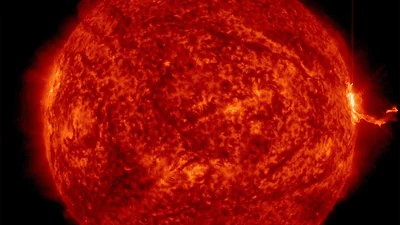
Sun Unleashes Powerful X-Class Solar Flares: What It Means for Earth
The sun is experiencing a surge in activity, firing off some of the strongest solar flares of 2025. This recent outburst, including X1.2 and X2.7-class flares, has already caused radio blackouts and raises concerns about potential geomagnetic storms affecting Earth.
What's Happening?
On May 13th and 14th, sunspot regions AR4086 and AR4087 erupted, releasing several powerful solar flares. The X2.7 flare, in particular, triggered strong R3-level radio blackouts across Europe, Asia, and the Middle East, disrupting high-frequency radio signals. According to NOAA's Space Weather Prediction Center (SWPC), flares of this magnitude are uncommon.

Why Are Solar Flares Significant?
Solar flares are sudden, intense bursts of electromagnetic radiation from the sun's surface. The classification of solar flares ranges from A to X, with X-class being the most powerful. These flares can cause radio blackouts by ionizing the Earth's atmosphere, disrupting radio communications, satellite navigation, and potentially impacting mariners and aviators.
Daisy Dobrijevic who joined Space.com stated that the eruption sent a blast of X-rays and extreme ultraviolet radiation hurling toward Earth at the speed of light, rapidly ionizing the upper atmosphere. This sudden change disrupted high-frequency radio signals, leading to communication dropouts for some radio operators across affected regions.
Coronal Mass Ejections (CMEs)
Adding to the concern, the X2.7 flare was associated with a coronal mass ejection (CME), a massive expulsion of charged solar plasma. While this particular CME isn't directed towards Earth, future CMEs from the active sunspot could potentially trigger geomagnetic storms. Geomagnetic storms can cause auroras visible further from the poles, as well as potential power grid failures and satellite disruptions.
Jess Thomson, a freelance journalist previously worked as a science reporter for Newsweek said this week's X1.2 and X2.7 flares were on the lower end of this most intense category; the strongest recorded flare in the last seven years was an X9 in October 2024.
Concerns for the Future
According to NOAA's Space Weather Prediction Center, there is a high chance of more M-class or even X-class solar flares in the coming days. As sunspot AR4087 rotates, Earth could be directly in its line of fire, increasing the risk of radio blackouts and geomagnetic storms. "Given the magnetic complexity of Region 4087, there's a 65% chance that M-Class level flare activity will occur through 17 May with a 30% chance for X-Class levels during the same time," they stated.

What do these solar flares mean for us? While radio blackouts can temporarily disrupt communications, the potential for geomagnetic storms raises broader concerns about infrastructure and technology. It highlights the importance of monitoring space weather and preparing for potential disruptions.
What are your thoughts on the increasing solar activity? Share your concerns and observations in the comments below.